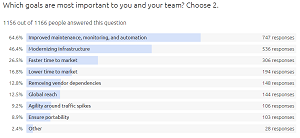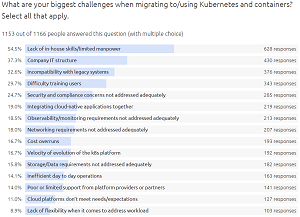News
Skills Dearth Hinders Enterprise Kubernetes/Cloud Native Adoption
Canonical published a new cloud native tech report with a focus on Kubernetes, finding that the growing ecosystem has yet to achieve full enterprise adoption, with a lack of in-house skills a primary challenge.
While Canonical is widely known for its Ubuntu Linux distribution, it's also a member of the Cloud Native Computing Foundation (CNCF) and thus published The Kubernetes and Cloud Native Operations Report based on data from 1,200 respondents to survey questions about hybrid and multi-cloud operations, Kubernetes, virtual machines (VMs), bare metal, goals, benefits, challenges, operators, advanced usage, edge and so on.
Along with survey data, the report comes with insights from industry stalwarts coming from Amazon, Google, the CNCF, WeaveWorks, Cloudbees and HCL Technologies.
"Despite high adoption rates of cloud native technologies in recent years, enterprises have yet to cross the chasm to full adoption, but they're quickly moving in that direction," Canonical said of the report.
They're moving in that direction because of perceived benefits -- the goals of using cloud native/Kubernetes -- including improved maintenance, monitoring, and automation (reported by 64.6 percent of users), modernizing infrastructure (46.4 percent), and faster time to market (26.5 percent) -- see the graphic below.
 [Click on image for larger view.] Goals (source: Canonical).
[Click on image for larger view.] Goals (source: Canonical).
Meanwhile, the top challenge to meeting those goals is a lack of in-house skills, reported by 54.4 percent of respondents, followed by company IT structure (37.3 percent), incompatibility with legacy systems (32.6 percent), difficulty training users (29.7 percent), security and compliance concerns (24.7 percent), and integrating cloud native applications together (19 percent) -- see the graphic below.
 [Click on image for larger view.] Challenges (source: Canonical).
[Click on image for larger view.] Challenges (source: Canonical).
Industry experts commenting on those challenges included Kelsey Hightower, a developer advocate at Google, and Alexis Richardson, founder and CEO of Weaveworks.
"They don't realize they already have a lot of the required skills," Hightower said. "Kubernetes is not where these skills originated ... (These are) new terms used for older concepts. Many people lack confidence, because they believe that the fundamentals have changed somehow."
Richardson, meanwhile, commented, "When people worry about the basics, i.e. security, costs, resources, observability and configuration, this is an indication that they haven't yet crossed the chasm of full enterprise adoption."
Those findings fit in with other surveys, such as The State of Kubernetes 2020 published by VMware last year, which found the top deployment challenge was "lack of experience and expertise" (70 percent), while the top management challenge was "lack of experience and expertise" (67 percent).
Another similarity between the two reports is lagging enterprise adoption, with VMware finding that on-premises installations outnumbered public cloud deployments for the then-5-year-old project, described as "still very young" by the company. "More than half of respondents (57 percent) are operating fewer than 10 Kubernetes clusters, and 60 percent are running less than half of their containerized workloads on Kubernetes," VMware said. "Early adopters of container technologies relied on other container orchestration tools (or no orchestration at all), and these environments remain in place. However, expect to see them supplanted by Kubernetes in the coming years. Kubernetes has all the momentum on its side."
The new Canonical report, meanwhile, indicated that 30 percent of respondents run applications on a mix of bare metal, VMs and Kubernetes, while 15.3 percent do so mostly on VMs -- planning to fully migrate to Kubernetes -- and 13.1 percent are on VMs and evaluating Kubernetes for deployment.
Other highlights of the new Canonical report include:
- Nearly 78 percent of respondents reported at least one hybrid or multi-cloud use case in production in their organization. This number is likely higher than reported when teams consider SaaS or third-party managed services -- those beyond what they directly manage themselves.
- The top users of Kubernetes and cloud native technologies are SRE/DevOps engineers, followed by infrastructure architects, back-end developers and full-stack developers.
- Asked what they consider the most valuable qualities of these technologies, respondents cited cutting-edge capabilities, developer productivity, elasticity and agility, global reach, open source, portability, reduced OpEx and CapEx, resource optimization and simpler operations.
- Most common use cases for hybrid and multi-cloud are acceleration of development and increased automation (20.7 percent of respondents), expanding cloud backup options to cut costs (13.3 percent), disaster recovery (12.6 percent) and clustering of mission-critical databases (5.5 percent).
- Cloud Native is more than Kubernetes. While 45.6 percent of respondents report using Kubernetes in production, only 15.7 percent report using Kubernetes exclusively.
-
21.4 percent of respondents are managing more than 500 machines, with a job role breakdown showing:
- Devs most commonly reported managing 1-5 machines (19.61 percent of developer respondents)
- Executives: 20 percent reported managing 201-500 machines
- Management had 2 answers tied for their top response: 13.8 percent reported managing 101-200, and another 13.8 percent manage 51-100.
- Ops: 1-5 machines was their lowest response (3.8 percent), 10.55 percent reported managing 5000+.
- Despite the unparalleled adoption rates of cloud native technologies during the past five years, both the ecosystem and its users have yet to cross the chasm of full enterprise adoption. 40 percent of respondents reuse traditional approaches from the VM world, (e.g. bash scripting), and 28 percent use Helm charts of varying maturity to manage software on K8s. To tackle enterprise software operation lifecycle management, operators might be the best solution, but the community has work to do to raise people's awareness and confidence levels in them. 30 percent of respondents suggest that trying out operators is on their to-do list.
-
The top benefits of cloud native technologies for businesses were assessed with a 1-5 ranking, finding:
- Elasticity and agility: Average 4.2
- Resource optimization and developer productivity: Average 4.1
- Faster time-to-market and simpler operations: Average 4
- Portability and open source software: Average 3.9
- Cutting-edge technology and global reach: Average 3.8
- Reduced OpEx and CapEx: Average 3.6
"The Kubernetes and cloud native community is set on a trajectory to redefine the way software is built, deployed and operated in the long term," Canonical said in conclusion. "It is a paradigm shift from traditional approaches, so it makes sense that the majority of users and businesses are still considering themselves as students rather than experts.
"There is surely a Kubernetes test environment in every organization that leverages software as the primary way to run its business, and it is very optimistic to see that people have started thinking about solving Day 2 to Day 1000 problems at scale and in a standardized way. The cloud native community is committed to improving users' experience while onboarding to Kubernetes and helping them address their challenges and business requirements by improving the technologies and sharing best practices."
The ongoing survey project is still active and this report will be published bi-annually shortly after every KubeCon event, with the next iteration planned for the week of KubeCon NA 2021, accompanied by a November 2021 report.
About the Author
David Ramel is an editor and writer at Converge 360.